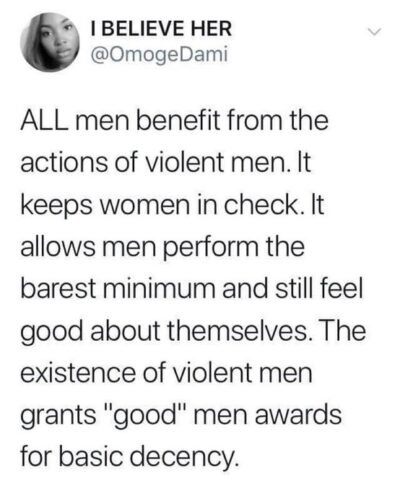For generations, women have been taught to fear the wrong things.We were warned about dark alleys, strangers, and the “unknown man” who might leap out
For generations, women have been taught to fear the wrong things.
We were warned about dark alleys, strangers, and the “unknown man” who might leap out of the shadows.
But the numbers tell another story.
And so do the lives of millions of Survivors.
Women are overwhelmingly harmed by men they already know.
Their own circles.
Their own homes.
Their own communities.
That truth has been steady across decades.
So when conversations about sexual violence turn into fear about another race — especially the old, dangerous myth that white women are most at risk from Black men — we need to bring the conversation back to real life, real patterns, and real protection.
Because myths do not keep women safe.
Truth does. AND, speaking that truth.
Why the Racial Myth Is So Dangerous
The lie that Black men are the biggest threat to white women has a long, violent history.
It fueled lynchings.
It justified terror.
It created a smear, mass incarceration, and a repeated pattern of injustice that still lingers today.
But it did something else too:
It kept women from seeing the dangers in front of them.
It kept them from asking deeper questions.
It kept them from recognizing patterns that cross every racial line:
control
entitlement
grooming
retaliation
silence backed by community protection
These are the real predictors of danger.
Not a man’s race. Not a man’s wealth. Not a man’s position or power.
But, men still get to hide behind all those things.
What Actually Puts Women at Risk
Across stories shared on this site, across support groups, across communities, the same patterns show up:
Men who feel entitled to women’s time, bodies, labor, or attention.
Men rewarded for dominance, never taught emotional regulation.
Men protected by institutions — families, churches, workplaces, schools, sports organizations, and political parties.
Men who use grooming, charm, or pity to disarm women.
Men who escalate when women set boundaries.
Men with unchecked access to women and girls.
These patterns appear everywhere.
Every community.
Every culture.
Women’s risk rises not because of a race, but because society still trains women to doubt their instincts and prioritize comfort — especially the comfort of men — over safety.
The First Real Safety Skill: Believing Your Own Knowing
Women are safer when they are allowed to trust themselves again.
When discomfort is taken seriously.
When silence is recognized as fear, not “overreacting.”
When boundaries are honored the first time they’re spoken.
When girls are taught early that their no is sacred.
When intuition is respected as wisdom, not dismissed as paranoia.
So much of survival begins with that internal shift:
I can trust what my body, spirit, and instincts are telling me.
The Second Safety Skill: Naming the Real Threats
Women are safer when conversations shift away from stereotypes and toward the actual patterns that harm women across the world.
Here’s what lifts safety:
Recognizing grooming signs early
Lowering chaos tolerance
Building spaces with boundaries
Teaching girls that peace is normal and deserved
Removing stigma around leaving when women feel unsafe
Holding communities, organizations, leaders, groups, families, and individuals accountable when they protect violent men
Prioritizing women’s health, safety, and dignity above convenience or tradition
This is where women’s protection grows.
The Third Safety Skill: Letting Go of the Myths That Never Served Us
When we name the truth, we take back power.
The myth of the “dangerous Black stranger” has never protected white women.
And it has never protected Black women or girls — who are often harmed, doubted, and dismissed, sometimes inside their own communities and often inside systems that were never built for them.
Real safety does not come from fear built on stereotypes.
Real safety comes from education built on patterns.
And women deserve education that actually keeps them alive.
The Bottom Line
Women of every race are more likely to be harmed by men in their own lives and spaces, not by strangers.
Safety improves when we pay attention to:
the patterns,
the behaviors,
the grooming,
the entitlement,
the boundary violations,
the institutional cover-ups,
and the silencing that follows.
This is the truth that saves lives.
This is the truth women pass down to each other in whispers, in circles, in late-night phone calls, in the places where survival and sisterhood meet.
And this is the truth we honor here.
“The government collects information on the race of victims and offenders. But in the most recent years, they do not publish a chart that clearly tells us how many white women were raped by white men versus Black men.
What we can say — from both long-term trends, the broader violent-crime data, and information from law enforcement and victim advocate organizations— is that women are overwhelmingly harmed by men of their own race. That pattern remains steady.
Since the exact, updated numbers for sexual assault alone aren’t publicly released, we stay honest about the limits of the data while still naming the pattern that has held true across decades.”
Going forward, we need research from unbought, unbiased, and reliable research institutions.
For good reason, women have lost trust in some of the institutions we once trusted.
Unbought data saves lives.
Uncompromised truth creates safety.
Reliable research gives communities the clarity needed to protect women and children before harm reaches them.
